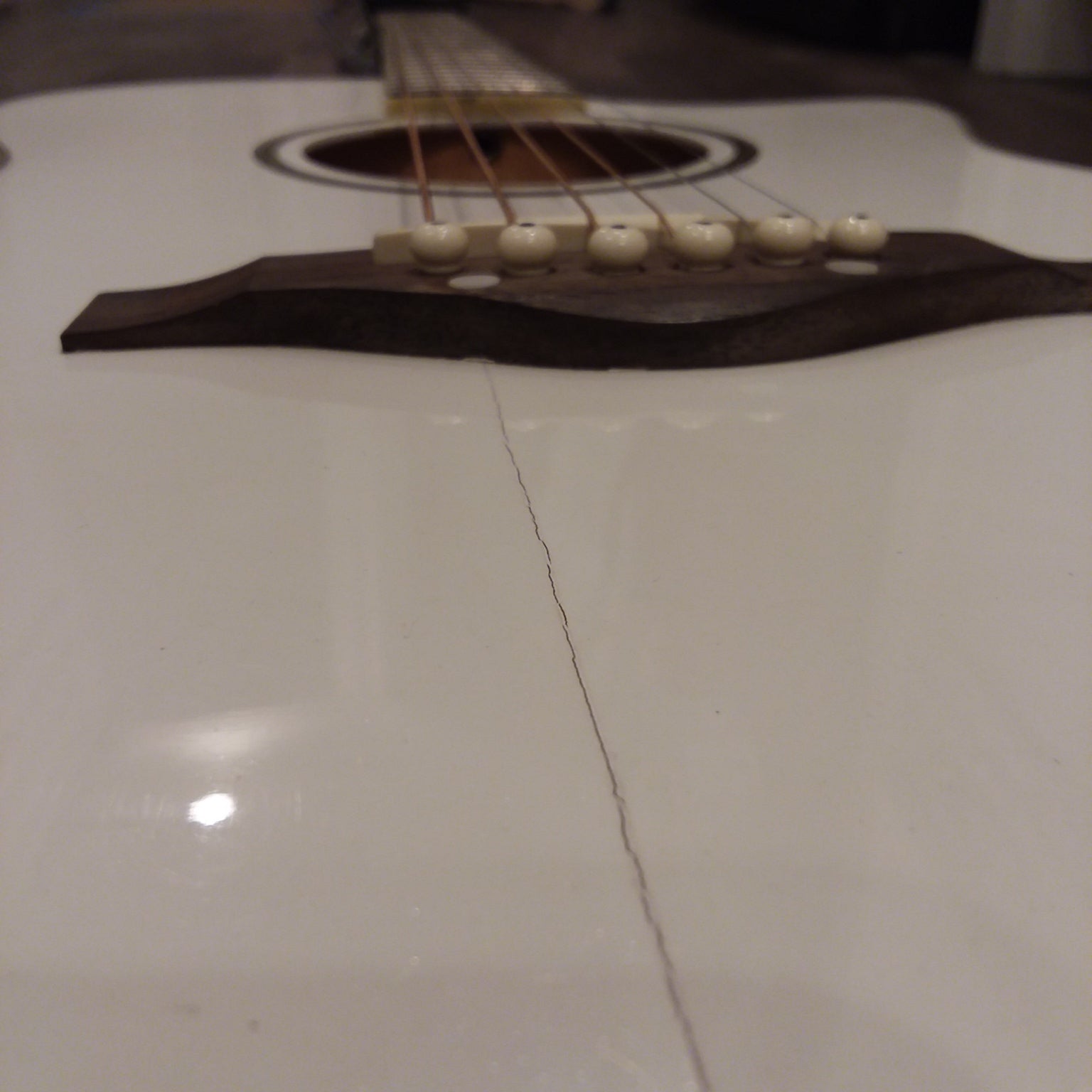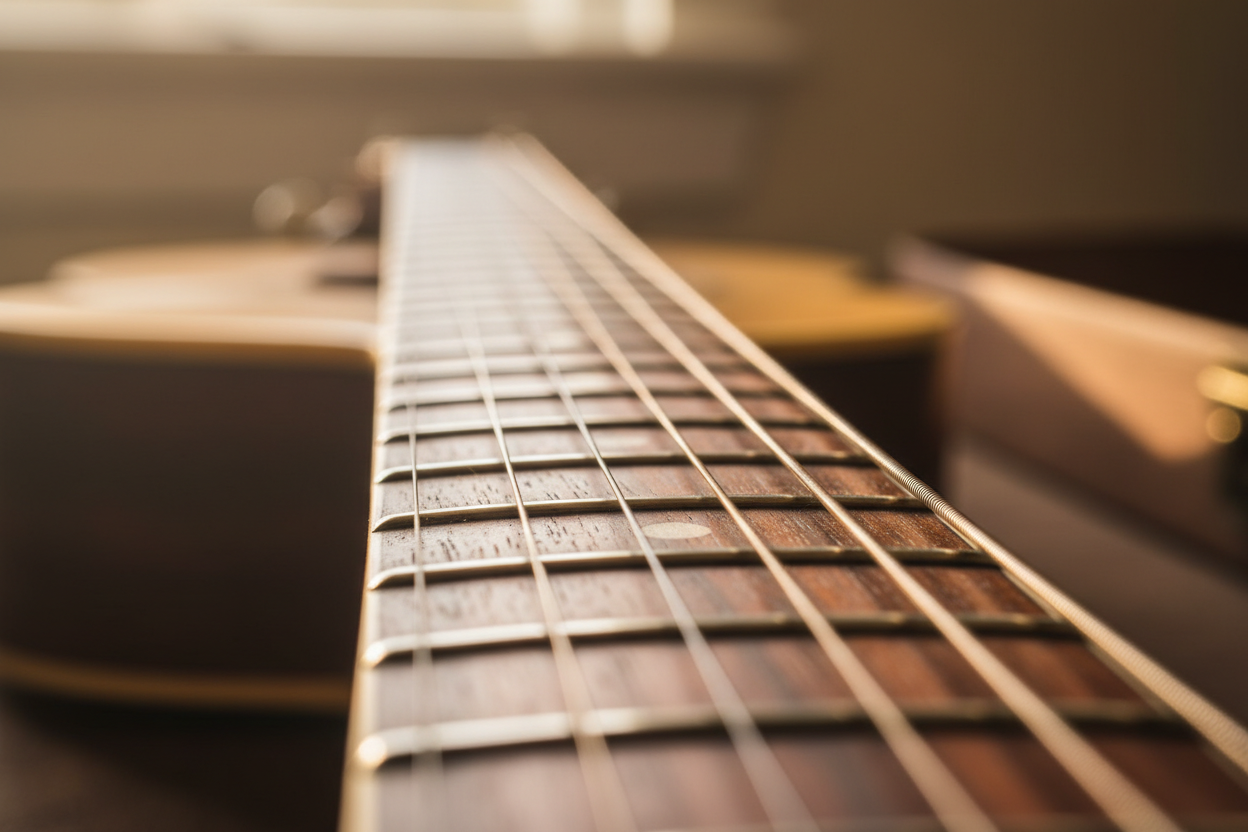If you live in a dry climate, or it's wintertime, you need to humidify your guitar. Wooden guitars need storing in a case or a room where the relative humidity is between 40% and 55%. Your RH levels can get as low as 20% when running a furnace to heat your home. These dry conditions can be hazardous to your guitar. The optimal RH level is 50%, try to avoid going under 40% or over a 55% relative humidity levels to protect your guitar from getting damaged.
What happens when a guitar has dried out?
If your guitar dries out, the wood shrinks and the top of your guitar can sink and cause performance issues. Worse yet, the guitar body can crack and glue joints separate, causing severe damage.
You can avoid these issues using a guitar humidifier when storing your guitar in a case or gigbag. A typical guitar humidifier is simply a sponge that releases moisture after wetting it. The sponge is encapsulated inside a plastic container that rests inside your guitar's soundhole suspended by the guitar strings.
Storing your guitar in a case or gigbag further protects it by sealing out dry air and retaining the moisture that evaporates from the humidifier, ensuring that it gets absorbed by your guitar.
What are the signs of a dry guitar?
- The action is low, and you have fret buzz due to the guitar top sinking inward.
- Fret ends are protruding from your guitar's fingerboard. Your wooden fretboard can shrink, leaving the frets sticking out past the edge of the guitar neck.
- The machine heads are loose and rattling. The holes that house your machine heads can expand as the wooden headstock shrinks, causing a loose fit.
- Neck hump on the fretboard where the neck connects to the body. This can give you fret buzz in the upper register of your guitar neck.
- Cracks, glue joints separating, and loose bindings.
What are some product solutions to keep my guitar humidified?
One of our favorites is the Music Nomad Soundhole Humitar. The reusable sponge holds 10x its weight in water to minimize how often it needs to be re-wetted. It will safely hydrate your guitar without spills or messes.

Music Nomad also makes a case humidifierthat will protect your electric guitar or any other case-stored instrument. To gain the maximum benefit from the humidifier, do not store it in any enclosed case compartments that would seal it off from protecting your instrument.

The case humidifier also comes with adhesive tape so that you can safely secure it and prevent any possible dings or scratches to your guitar during transit.
Monitor your relative humidity levels with a hygrometerto avoid over or under hydration. Overhydration can damage a guitar as well and should be avoided. An overly wet guitar can cause swelling of the wood, causing the tops to rise, which can loosen the bridge and bracings. If the humidity levels are high in your home, you should invest in a dehumidifier. It will also help in preventing oxidation of anything metal on your guitar.
For those who don't mind paying more for convenience, D'Addario makes a great 2-way humidification system called the Humidipak. It automatically controls the climate inside your case, keeping it from getting too dry or wet. The packs last 2 to 4 months.

The Humidipak generally has a shorter lifespan in the winter and will last longer during the summer months. You'll know when to replace it when the gel inside the packet hardens. You can purchasereplacement packets for a lesser cost than the complete system.
Rehydrate a dry guitar
If you know your guitar is dry and in need of rehydration, you can use the D'Addario Humidak Restore system. This packet is designed to bring your guitar back to the proper level of hydration. You should not ever use it on a guitar that is already at a healthy RH level, which could lead to overhydration.

I hope this article has been helpful to anyone researching guitar care and storage. Maintaining the proper RH levels will avoid damage to your instrument and also improve the tone that it produces. If you know others that might benefit from this knowledge, please share this article with them so that they, too, can prevent the damages of a dry guitar.
If you have any questions or comments, please let me know down below, and I'll be happy to answer them.




